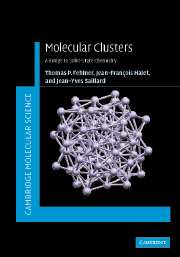Book contents
- Frontmatter
- Contents
- Preface
- 1 Introduction
- 2 Main-group clusters: geometric and electronic structure
- 3 Transition-metal clusters: geometric and electronic structure
- 4 Isolobal relationships between main-group and transition-metal fragments. Connections to organometallic chemistry
- 5 Main-group–transition-metal clusters
- 6 Transition to the solid state
- 7 From molecules to extended solids
- 8 Inter-conversion of clusters and solid-state materials
- Appendix: Fundamental concepts: a concise review
- Problem Answers
- References
- Index
- References
6 - Transition to the solid state
Published online by Cambridge University Press: 19 February 2010
- Frontmatter
- Contents
- Preface
- 1 Introduction
- 2 Main-group clusters: geometric and electronic structure
- 3 Transition-metal clusters: geometric and electronic structure
- 4 Isolobal relationships between main-group and transition-metal fragments. Connections to organometallic chemistry
- 5 Main-group–transition-metal clusters
- 6 Transition to the solid state
- 7 From molecules to extended solids
- 8 Inter-conversion of clusters and solid-state materials
- Appendix: Fundamental concepts: a concise review
- Problem Answers
- References
- Index
- References
Summary
The theme of this text, clusters as a bridge to solid-state chemistry, requires that we now consider the geometric and electronic aspects of substances that are solids. In doing so we will focus our attention initially on the nature of the atomic structures inside a bulk material; that is, we will completely ignore the surfaces. Towards the end of this chapter we will reincorporate surfaces into the problem and, in doing so, complete the bridge. The electronic-structure problem presented by periodic structures exhibiting extended bonding has been effectively dealt with in several earlier texts some of which are listed at the end of this chapter. These works go beyond what we need to establish our theme; however, the reader interested in more depth and breadth is referred to them.
Cluster molecules with extended bonding networks
As usual, let us begin with a discussion of geometric ideas relevant to a transition from molecular clusters to the solid state.
Surface vs. core atoms
In the structure of [Al69R18]3− (Figure 2.32) the number of nearest-neighbor Al atoms and bonding parameters changes in going from the outer shell made up of Al–R fragments deeper into the inner shells constructed from Al atoms alone. The internal cluster atoms display coordination numbers and inter-atomic distances more closely associated with bulk elemental Al than single-shell clusters. Is this reasonable? For the single-shell clusters discussed in preceding chapters the requirement for external ligands dominates the cluster stoichiometry/shape relationship.
- Type
- Chapter
- Information
- Molecular ClustersA Bridge to Solid-State Chemistry, pp. 205 - 256Publisher: Cambridge University PressPrint publication year: 2007



